Entries Tagged 'Razors' ↓
October 24th, 2010 — Razors
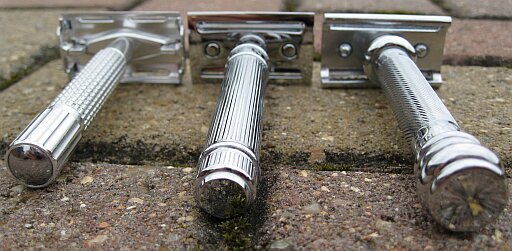
Weishi, Edwin Jagger DE89L and Merkur 39C safety razors
It strikes me that in a traditional wet shave with three passes each of those passes is doing a different thing. In the first pass most of the hair is removed, so this requires a razor that really munches through the stubble effortlessly. In the second pass a fair amount of hair is still being removed but there is more across the grain (XTG) and against the grain (ATG) work so this requires a razor that is very smooth yet still able to remove a lot of hair. The third pass is touch up and putting a finishing touch to things so a nice mild razor is needed.
Now some would say this is what an adjustable is for, just click it down between the passes. And yes, I have done this and it works with my Mergress and my Gillette adjustables. But by going for different razors you are going for more than just a change in blade exposure, you are going for a change in the whole feel and action of how the razor works. So the three razor method has to work better, it is just a matter of choosing the right razors.
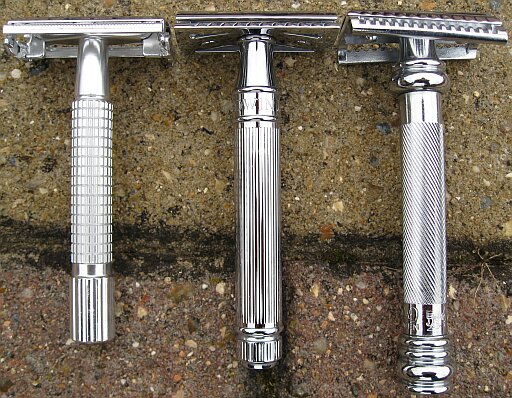
For the first pass the obvious choice of razor has to be the Merkur 39C Slant Sledgehammer. There can’t be much that is more efficient at removing stubble, the scything action of the slant bar goes through anything you can offer up with consummate ease. And yet, surprisingly, it isn’t an aggressive razor to use. An alternative to the 39C as a pure whisker muncher would be the Mergress turned up to 4 and a bit. But between the two I think that the 39C is the better tool for this job.
The second pass is the perfect place for the Edwin Jagger DE89L, since it came out this razor has won many friends for its all round ability. It is recommended to beginners as a starter razor because it doesn’t bite, yet at the same time it is an efficient cutting tool that all shavers should be able to appreciate. This is just perfect for going XTG and ATG. An alternative would be the Merkur 38C Barber’s Pole, another fine razor. But owning and using both of these the Edwin Jagger shades it.
The third pass has to be the natural home for the Weishi razor from China. You would have to try very hard indeed to get this lightweight Super Speed clone to cut you, it is so benign. Yet when you get the angle right (and with this razor angle really is critical) then it is still a masterful piece of shaving equipment. I don’t know any other razor that behaves like this. Which means it is just perfect for touching up, you can go after those difficult patches with no danger of causing weepers. Alternatives would be a vintage Super Speed or a vintage Tech, but really the Weishi is better.
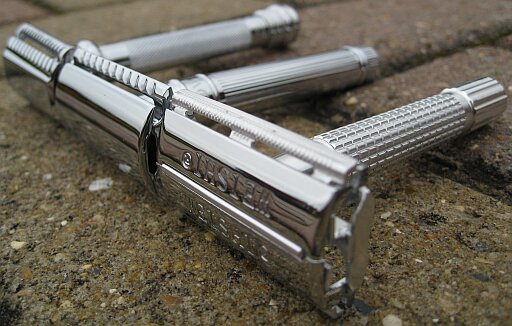
Now the big thing about traditional shaving is that all the choices are down to the individual (not to some massive multinational “personal products” conglomerate) so you may disagree strongly with my choice of razors. Feel free to do so because that is part of the fun and enjoyment. However I feel that the principle of three different razors for three different jobs carries some weight and is worth experimenting with.
So putting theory into practice does it work? The answer is as an unequivocal yes. The 39C likes a sharp blade in it for its action to work and it certainly removes most of the hair in just one pass. The DE89L is less blade sensitive and smoothly gets rid of virtually all the rest. You could stop now after 2 passes. But for the best shave the Weishi pass makes a big difference and you can buff the problem areas in a way that would be impossible with a more aggressive razor.
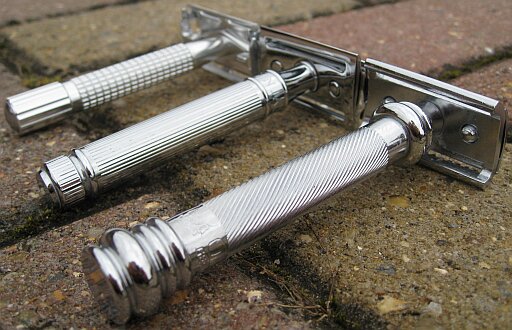
The net result is a very quick and efficient transformation from stubble to smoothness. Not only is it quicker but it has less impact on the skin. The method causes less trauma. For someone with sensitive skin this would be a winner.
From a practical point of view you can either use one blade and switch it or you can use 3 separate blades. I shave in the shower which makes the blade change interesting, to put it mildly. But having three blades out triples the amount of time they are exposed to a wet environment.
Of course it isn’t just the razor that is involved here. You could also go for a three different razor blade method. For the first pass you could use a Kai or a Feather, then for the second pass an Astra or an Iridium (if you are one of the lucky ones) and for the third pass a Personna or a Derby. Or you could go for some combination of razors and blades. Or experiment by mixing and matching till you get what suits you.
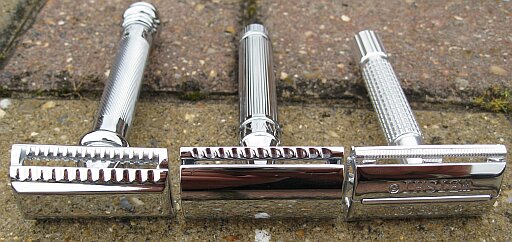
October 23rd, 2010 — Razors
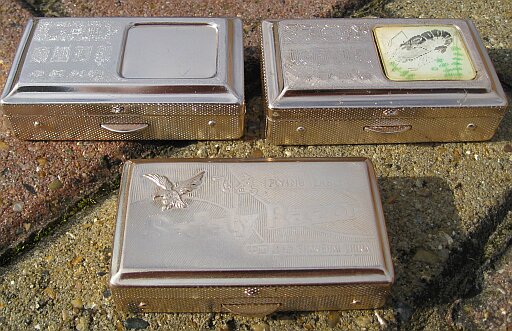
When it comes to traditional shaving I have a fair bit of kit, however it is far less than many others own and I am a user of this stuff not a collector. OK so I have two Toggles, but one is going for replating whilst the other stays original. But in general I think that I have the OCD under control.
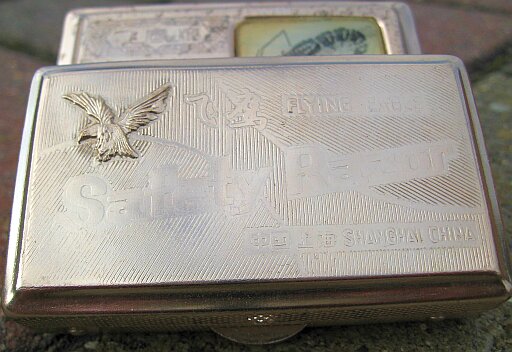
However I must admit that Flying Eagle razors are very tempting and I have written about them before. Mostly I like the beautiful embossed tin travel boxes they come in. But some of the coloured handles are also nice. These razors have been in production for some years and there is a wide range of box designs, many with different moving pictures on them. This wholesaler in Hong Kong has a good variety.
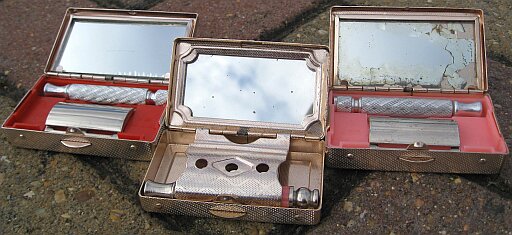
They are made in Shanghai, China by Kwang Yung Safety Razor Set Factory but they are not generally sold in the West. However they sometimes come up on eBay for very low prices indeed, mainly because most people don’t know what they are. To shave with they are reasonably mild but quite effective. You could definitely actually use one as a travel razor.
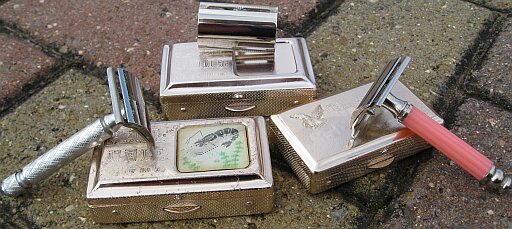
October 21st, 2010 — Razors
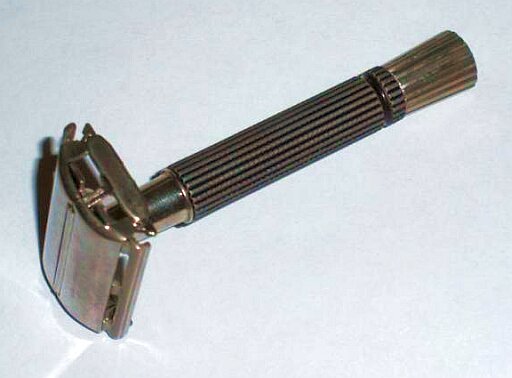
I think this is a fantastic thing that has been done here. Stingraysrock (Jeff) is a member of the Damn Fine Shave The Shave Den forum who is selling off a quantity of vintage razors for just $10 each. These are mainly Gillette Super Speeds and he is doing this specifically to help introduce people to double edged (DE) shaving. The Super Speed is perfect as a newbies razor. Obviously these are not in Collectors’ condition, but they are more than adequate for actually shaving with.

Not only is he helping others discover the joy of traditional shaving, he is also contributing $2 per razor to Damn Fine Shave The Shave Den, which is one of the few forums that deserve such support.
October 12th, 2010 — General shaving chat, Razors, Uncategorized
October 2nd, 2010 — Razors
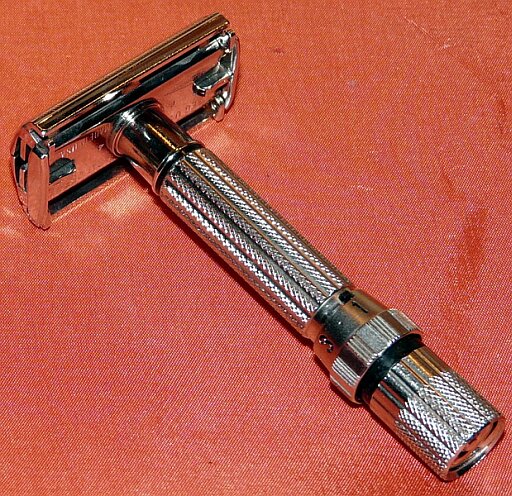
The engineering drawings here are just fantastic. This is patent number 2,952,911 filed on March 19 1956 and issued on September 20 1960, a gap of four and a half years. The inventors are Meyer J Shnitzler and Michael Douglas Benedict Jr. As you can see the adjuster in the drawings went from 1 to 5 and in the production Fat Boy, Toggle, Slim etc it went from 1 to 9. Also the adjuster in the drawings is near the bottom of the handle just above the twist to open (TTO) knob whilst on production items it was moved to just under the head.
Gillette built a very small number of prototypes as per the patent drawing. These now are extremely valuable. There is one in the photograph above.
Another complication here is that Gillette actually had two different adjustment mechanisms. The one in the Toggle adjustable moved the guard bars. The one in the Fat Boy bent the blade to differing degrees. This patent says: “This results flows from the fact that the relative positions of the guard member is controlled by the adjusting knob”. So it looks like it isn’t the Fat Boy mechanism.





October 1st, 2010 — Razors
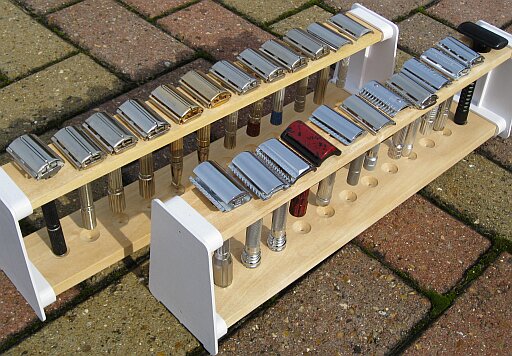
Many people who are into real, traditional shaving own several razors. This is understandable, razors are like cars with each make and model having its own personality and characteristics. In fact there are several that are considered “must haves”, especially some of the vintage Gillette models such as the Tech, the Fat Boy and the Super Speed. Some people amass large collections, which is not a bad idea when you consider just how fast some of them are going up in value.
Once you have started accumulating a few razors you have the problem of storing them. The upsurge in real shaving is so recent that there is little out there in the way of ready made solutions. The need is for something that allows the razor to dry out after use, that makes them easily accessible, protects them and keeps them organised. Here are a few ideas:
Razor stands. These tend to be designed to hold just one razor, usually as a set with just one brush. The makers of these obviously haven’t seen my bathroom. The acrylic stands from Cutting Edge Razors in America are just about the best that I have seen.
Toothbrush stands. Some of these are designed to be used by the whole family with room for 4 toothbrushes/razors, so they can be a good solution when you are starting your collection. They tend to be chromed metal or ceramic so have more Mohs of hardness than many razors, so they could be less kind to your razor than you may like.

Test tube stands. This is currently my favoured solution, you can store a lot of razors in a small space, they are cheap, the wood is kind to the razors and they keep things organised. You can get a wide range of different sizes to match your bathroom and your razor collection. Some people paint or varnish their test tube stands so they look nicer. The only weakness is that some very long handled razors can end up not hanging.
Pipe racks. People have been smoking and collecting pipes for centuries so there is a well established industry out there supplying storage solutions, many of which are perfect for storing DE razors. Some are highly decorative and some can be valuable antiques in their own right. Type “pipe rack” into eBay and you will be amazed with the vast variety on offer, some are plainly unsuitable but most are.
Spoon racks. It appears that collecting spoons is yet another manifestation of OCD and they have the storage solutions to go with it, many of which are just perfect for a razor collection. Once again eBay comes up with a large and varied selection, some new and some vintage and some with space for as many as 100 razors.
With all these possible solutions take care to make sure that your razors actually fit.

September 24th, 2010 — Razors

When people look for vintage razors to put to daily use today they mostly think of Gillette, who manufactured very large numbers of well engineered razors which, with care, have an almost infinite life. But there were many other, smaller, razor manufacturers around the world, some of whom made very good razors and one of the very best was James Neil & Co of Composite Steel Works, Napier Street, Sheffield, England, who manufactured the superb Eclipse Red Ring razor.

At the time that the Red Ring was designed Britain was still the world’s superpower with the biggest empire ever seen and a technology base to match. The unions and socialism were yet to yield their destructive power. Robert Watson Watt was inventing radar, Frank Whittle was inventing the jet engine, Alexander Fleming was inventing antibiotics, Ernest Rutherford was splitting the nucleus and Reginald Joseph Mitchell was designing the Spitfire.
The Red Ring had several innovations and was protected by patents. British patent no 344280 by W. V. Hudson and J. L. Pickerell is from 5 March 1931 and British patent no 380958 was granted in September 1932 to J. Neill & Company Limited. Innovations include the head design, the adjustment mechanism and the magnet. It is quite a heavy razor at 62.1 grams (2.19 ounces).

The head design is like no other before or since. On the bottom plate there are teeth but these have a solid guard bar before and below them, the top plate has matching grooves. The head is a fairly mild shaver but is unusually effective at cutting through the stubble. What I think may be happening is that the curved profile of the teeth, just before the blade, moves the hairs sideways into the edge. This creates a scything action a bit like a slant bar razor. However it works, it gives a unique and excellent shave. Also it is particularly insensitive to the angle you use it at, it seems to find its own perfect stance as you shave.

The adjustment mechanism was a quarter of a century ahead of the Gillette Fat Boy, it works in a similar manner to today’s Merkur Progress, you turn a knob on the bottom (which has an arrow on it) up fully for mildness then slacken it off slightly for more aggression, there are markers on the handle so you can calibrate your setting. Unlike the Progress it clicks as you wind it back.
The magnet is a small but very nice touch, handling double edged blades takes some care and with the magnet life becomes a lot easier, especially when picking a blade up from a flat surface. You wonder why more razors don’t have this useful feature.

The wonders of the Eclipse Red Ring are not all over yet, there is the logo. This is the very height of Art Deco and depicts a stylised solar eclipse. A square moon is moving in front of a square sun which has rays shooting off it.
If you want to own an Eclipse Red Ring there is good news and there is bad news. The good news is that it is a robust razor and was in production till the 1950s, so they are still about and come up fairly regularly on eBay. It was chrome plated, which was very rare in that era and we know from our Mohs that this makes it more durable. The bad news is that just about every traditional shaving enthusiast wants one (or more), which is quite understandable. It is one of the most sought after of razors and the price is rocketing, even over the last few months they have more than doubled in value. Expect to pay £50 to £100 for an OK to use example, double that if it is in its original box and add another 50% if it is in mint, new condition. These prices can only go up as demand far exceeds supply.
James Neil & Co became a part of Spear and Jackson, which is still thriving today. If they still have the tooling for this razor they could put it back into production to satisfy the demand and we would have a rival for Merkur.

My Eclipse Red Ring
September 22nd, 2010 — Razors
I have written on here before about iKon razors, they have a good reputation both for product quality and for the good shave that they give. So I asked Greg at iKon if he wanted to write an article to give us some background as to how the razor came about.
How iKon Razors Got Started. By Greg / Ikon Razors

Razor bumps.

I always had a line of razor bumps right at the baseline of my neck where my stubble started, it was there and pretty much everything I tried had little effect on it.
Then a little over 2 years ago I discovered double edge razors. Using a DE razor and some better quality shaving creams (I highly recommend The Body Shop Maca Root Shaving Cream) really worked for me as all the modern day multiblade contraptions really do is just shear and push the remaining stubble back into the follicle it naturally grew out of, whereas a sharp DE blade slices the hair clean off in a single pass. Older technology really worked well in this regard and the choices of double edge razor blades are great with something to suit even the most demanding shaver out there.
R.A.D. (Razor Acquisition Disorder) then set in , I was hooked on this new method of shaving and had to try every product out there. Some were great but I saw room for improvement. The idea to make stainless steel razor was born.

As an avid outdoorsman and parent of young children another appeal of using a classic style double edge razor is from a conservation viewpoint, the statistics of how many disposable plastic razors are thrown out per year are astounding & immense. Shave The Earth , use a double edge razor that creates minimal waste and saves money as well. Most men spend approximately $250 a year on disposable razors and shaving cream from a can – both proven equally bad for our now fragile ecosystem. After the initial investment of buying a high quality safety razor that will effectively last a lifetime, a realistic yearly shaving cost will average $59 per year.
Why not a stainless steel safety razor ? The very first iKon razor was made.

Totally hand made on a milling machine & industrial lathe from a stainless steel billet with the handle turned from a piece of 316L bar stock stainless steel rod , a method we still incorporate today. From there it was a matter of perfecting this idea, the first iKon production razors were made using a slightly more technical manufacturing process using a series of processes such as machining, wire cutting, bending brakes and welding



Not an easy task I learned, as perfecting a razor head, getting the blade to sit aligned consistently and perfectly proved a challenge, these images were of the early iKon 3 pin style heads that are no longer being made and now considered by many collectors items. No more than 75 of these razors were made.

Our current iKon razors use what I feel is the best blade locking mechanism available , known as a slot bar – it provides the best consistent blade alignment possible.


A website was needed to help with all the incoming queries about this new product , www.ikonrazors.com There is a strong demand in today’s modern wet shaving market for superior made safety razors, we are at the forefront of this. iKon continues to refine and develop this new product that initially started on a whim to create something I intended to use myself. The current iKon designs are totally user inspired, taking what were considered the premier double edge razors designs from yesteryear and modifying them into modern professionally machined “shaving tools”. We listen to our customers and take every comment and suggestions into consideration when making our products.
A razor’s aggressiveness is very subjective to the end user and often I am asked to recommend what razor is best for a new perspective iKon owner. A simple solution to a hard problem was to make a less aggressive standard head razor and also special open comb razor head that has a bit more shaving edge exposed for those with heavier beards. Also creating two handle styles using a special deep diamond knurling technique offering an incredibly positive grip to compliment our razor heads . A classic long handle that is equally as effective as our short robust bulldog handle, again a simple matter of preference for the end user. With these initial two head and handle design options we are pretty much covering the demands of the most discerning wet shaver out there.

The end result was so successful more iKon designs are currently under design works, the possibilities are limitless and I have some great ideas.
– Greg / iKon Razors
September 19th, 2010 — Razors
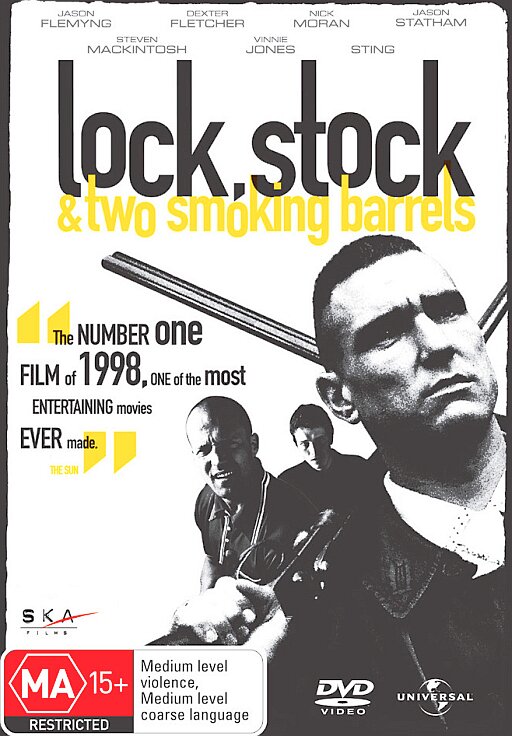
Friedrich Mohs, a German mineralogist, invented his eponymous scale of hardness in 1812. It compares substances by their ability to scratch each other, with diamond at the top with a score of 10. This is quite important to us traditional shavers because it gives us an idea about the potential longevity of our razors and also is very useful to know when re-plating a razor.
Gold is pretty soft with a Mohs of 2.5. Lots of razors from many manufacturers have been gold plated and it is totally unsuited to the job, I have two gold plated toggles and they have worn in the key contact areas. Gold might be OK for a razor you are going to just display and look at, but it isn’t what this blog is about. It has rocketed in price recently to $1,275 an ounce.
Silver comes next with a Mohs of 2.7, which isn’t much better, and it has the unfortunate tendency to oxidise to dull grey. At one stage Gillette silver plated a lot of razors but it has fallen out of fashion today. It is relatively cheap though, at $21 an ounce.
Nickel was Gillette’s plating material of choice through most of its classical production and many of those razors are still pristine today, so it is surprising to find that it has a Mohs of just 4. Nickel is $23,000 per tonne so is very cheap indeed.
Palladium is next, used by the Joris razors from France, this has a Mohs of 4.75. To put this into perspective human tooth enamel has a Mohs of around 5 so it is pretty similar. Currently it is $557 an ounce.
Rhodium is massively expensive, currently over $2,000 dollars an ounce (but it doesn’t take much to plate a razor). It has a Mohs of 6, which is the same as Titanium. Gillette plated some of their most special razors with this, I have a British Aristocrat #66 Coronation razor and it is very bright and shiny indeed. Rhodium is becoming increasingly popular for re-plating old razors.
Chrome is the plating of choice for a lot of modern razors from the likes of Merkur, Muhle and Edwin Jagger, it has a Mohs of 8.5 so is pretty hard, but we all know from our experience with cars just how it can be subject to tarnishing if it isn’t done just right.
Of course metal hardness isn’t the only factor when it comes to metal plating, however it does have a huge bearing on durability which makes the Mohs information useful to know.
September 9th, 2010 — Razors
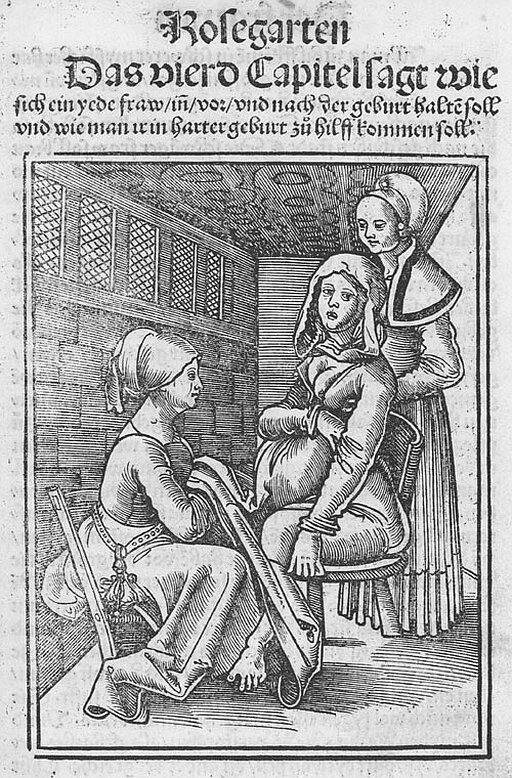
This is something rather nice that you can do with traditional, real shaving. Gillette have been the dominant manufacturer of shaving equipment on planet earth for about a century. During all of that time they made fantastic, well engineered, very high quality double edged safety razors. Nowadays these are reserved for developing countries where the bulk of the male population cannot afford several dollars every week for a system razor cartridge. But for many decades they were the prime Gillette product in Western markets as well.
Gillette double edged razors are made to last, their potential life is virtually indefinite. I have a 1930s Tech that I use regularly, many people still use razors made before World War 1. So there are tens of millions of these razors hidden away in attics and garages that, after a quick cleanup, would still make fantastic shaving razors today. I have a small collection of these, which I use, and have written about the Super Speeds and Adjustables on here before. Tens of thousands (maybe more) of real shaving enthusiasts seek out and use these razors, their prices go ever upwards on eBay.
One very interesting feature of Gillette razors is that with very many of them you can tell when it was manufactured. So you can buy one made in your birth year. From 1904 to 1931 each razor carried a serial number. Though from 1921 to 1931 this was just for the top models. And there was a brief period in 1927/8 when there were no serial numbers. If you have a serial numbered razor then you can easily look it up against online tables to get its manufacturing date.
From 1931 to 1950 there were no distinguishing marks, then in mid 1950 they started again with a new system. There is a letter of the alphabet for the year and a number for the quarter within the year. The first razors under this system were marked V3. They worked their way through the alphabet till 1955, when they started at A again. Then in 1980 they started at A yet again. With this system you can buy a razor within a 3 month window within which your birthday lies.
Looking at some of my razors there is a red tip Super Speed that has B2 stamped on the underside of the head, this razor was made in April, May or June of 1956 and it still shaves perfectly today. I have 2 Toggles, a D1 and an F4, they are from Quarter1 1958 and Q4 1960 respectively. And for a more modern razor there is a fantastic S4 long handled Super Adjustable which is from Q4 1972.
When you see Gillette razors advertised you will often see the date code included in the description. Some people collect the date codes. So, say, the Fat Boy was made for just four years and it would be quite simple to accumulate one made in each quarter that it was manufactured. By chance both of mine are stamped F4.
As with everything to do with personal shaving date of birth razors are a personal thing, to some people they are important and they hunt them down, other people just can’t be bothered. It is up to you.












































